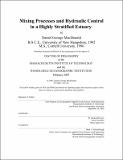Mixing processes and hydraulic control in a highly stratified estuary
Author(s)
MacDonald, Daniel George, 1970-
DownloadFull printable version (13.66Mb)
Other Contributors
Massachusetts Institute of Technology. Dept. of Civil and Environmental Engineering.
Advisor
W. Rockwell Geyer.
Terms of use
Metadata
Show full item recordAbstract
This thesis utilizes field data from the Fraser River Estuary, a highly stratified system located in southwestern British Columbia, Canada, to investigate the nature of mixing processes in a highly stratified environment, and to extend two-dimensional hydraulic theory to a three dimensional environment. During the late ebb, a stationary front exists at the Fraser mouth. Although densimetric Froude numbers in the vicinity of the front are supercritical in a frame of reference parallel to the local streamlines, the front itself is oriented such that the value of the Froude number is equal to the critical value of unity when taken in a frame of reference perpendicular to the front. This observation presents a robust extension of established two-dimensional, two-layer hydraulic theory to three dimensions, and implies similarity with trans-sonic flows, in that a Froude angle can be used to identify critical conditions in a manner similar to the Mach angle. Mixing processes were evaluated at the mouth during the late ebb using a control volume approach to isolate mean vertical entrainment processes from turbulent processes, and quantify the vertical turbulent salt and momentum fluxes. Observed turbulent dissipation rates are high, on the order of 10-3 m2s-3, with vertical entrainment velocities on the order of 2 x 10-3 m s' . Mixing efficiencies, expressed as flux Richardson numbers, are confined within a range from 0.15 to 0.2, at gradient Richardson number values between 0.2 and 0.25. (cont.) These results are consistent with previous laboratory studies, but represent energetic conditions that are several orders of magnitude higher. In the estuarine channel, the variability of mixing processes was investigated through the tidal cycle using control volume and overturn scale methods. Spatially, mixing was observed to be more intense near a width constriction on the order of 25%. Temporally, more dominant mixing was observed during ebbs, due to increases in both vertical shear and stratification. Mixing is active and important throughout the tidal cycle, and was found to be the dominant process responsible for removing salt from the estuarine channel during the ebb.
Description
Thesis (Ph. D .)--Massachusetts Institute of Technology, Dept. of Civil and Environmental Engineering, 2003. Includes bibliographical references (p. 207-214). This electronic version was submitted by the student author. The certified thesis is available in the Institute Archives and Special Collections.
Date issued
2003Department
Massachusetts Institute of Technology. Department of Civil and Environmental EngineeringPublisher
Massachusetts Institute of Technology
Keywords
Civil and Environmental Engineering.